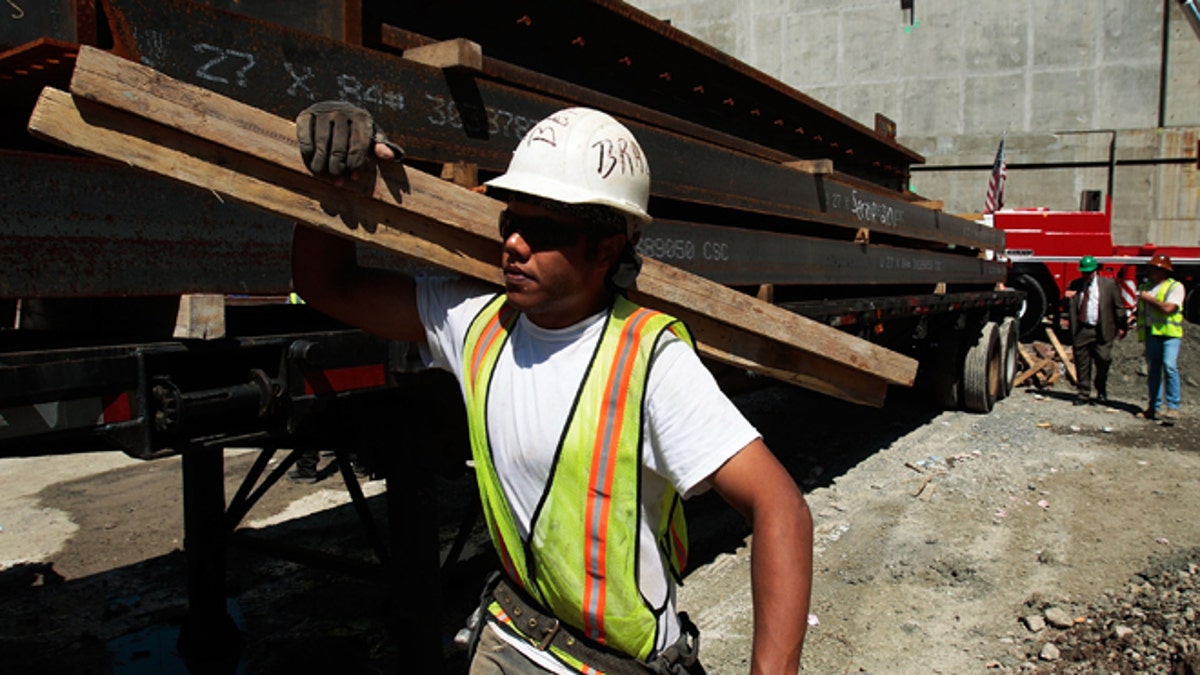
NEW YORK - SEPTEMBER 02: A worker carries wooden planks at Ground Zero September 2, 2008 in New York. Construction workers started erecting the frame of the National September 11 Memorial and Museum nearly seven years after the terrorist attacks destroyed the World Trade Center. (Photo by Chris Hondros/Getty Images) (2008 Getty Images)
A new analysis of federal safety data found that while overall jobs in the construction industry are getting safer, Latino workers are still getting injured at alarming rates.
According to the data, between 2010 and 2013, the number of deaths among Latinos in the construction industry rose from 181 to 231. The number of deaths also rose in the industry overall, from 774 to 796, but that increase is attributed entirely to Latinos. During the same period, deaths for non-Latino construction workers fell from 593 to 565.
Each day across the country, hundreds of day laborers and migrant workers wait in street corners waiting to get hired. They are sometimes picked up by contractors or subcontractors looking to cut corners by hiring cheap labor that won’t expect benefits – most undocumented workers live in the shadows and, in general, don’t qualify for any federal benefits.
"There’s a clear correlation between low-wage jobs and unsafe jobs," said Occupational Safety and Health Administration chief David Michaels, according to the Nation. "Workers in low wage jobs are at much greater risk of conditions that will make it impossible for them to live in a healthy way, to earn money for their family, to build middle class lives."
Another reason for the spike in deaths is a rise in safety violations on job sites run by smaller, non-union contractors and an unwillingness by some undocumented workers to report violations, according to a 2013 study by the New York State Trial Lawyers Association.
"Contractors aren’t taking simple steps to protect their workers," Connie Razza, from the Center for Popular Democracy, told the New York Daily News. "They are not providing the training and the safety equipment that are required by law."
Advocacy groups are working to combat any changes to New York’s scaffolding law, which organizations like the Center for Popular Democracy say gives incentive to keep workplaces safe. The law holds owners and contractors who did not follow safety rules fully liable for workplace injuries and deaths.
Contractors argue that it has driven up insurance costs to record levels.
Lawmakers, however, have historically blocked any of the proposed changes to the law.
"All we’re looking for is the ability to have the same right as anybody else would in the American jurisprudence system," said Louis J. Coletti, president and CEO of the Building Trades Employers' Association.
In an attempt to make their work environments safer, some day laborers have joined together to seek protection through collective action. In the wake of Hurricane Sandy, some day laborers in New York City turned to one another about the dangerous conditions, and decided together how to deal with them.
The Bay Parkway Community Job Center in Brooklyn brought in safety experts for guidance; community groups and foundations rallied around the laborers, helping them buy their new trailer with several grants.
With the help of organizations such as the Worker’s Justice Project, laborers learned about wage and hour laws, the hazards of exposure to certain building materials and what kinds of actions or treatment by the people who hire them constitute abuse and violations.
"When something isn’t right, at that moment, you may not realize it or attach much significance to it," Rafael Tecpanecatl, a laborer who came from Mexico 11 years ago told Fox News Latino. "I’ve worked many jobs that I realized later were hazardous to my health. I’d get on ladders that were not steady, I’ve sanded walls and cut plywood and had debris go into my eyes and lungs."
